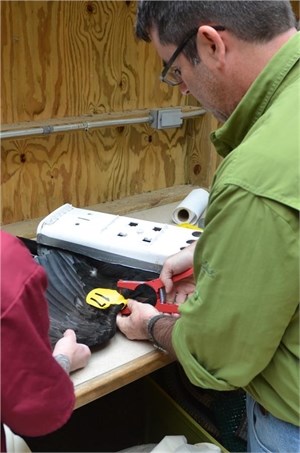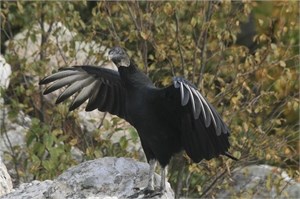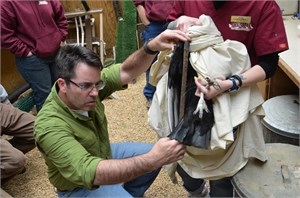Combining training with research
Wing tagging black vultures
Posted on May 13, 2013 in Science

The next time you see a vulture circle overhead or bent over a carcass, stop and check the wing to join Hawk Mountain as a citizen scientist. Simply look for a brightly colored tag showing a distinct number, then call or email the color, number and location to Research Biologist David Barber at [email protected] or 570-943-3411 x105.
Wing tags, also called Patagial Tags by scientists, are a low-cost and easy way to identify and monitor the movements of large soaring migrants and vultures fit the bill. Birders equipped with binoculars and anyone else with good observation skills can easily spot the tags and report, offering a huge boost to the study.
In May 2013, an easy opportunity to tag a black vulture presented itself at the Tri-State Bird Rescue and Research where a bird was nesting comfortably in an abandoned shed, a popular nest site for vultures, who actually don't build a nest at all.
Like all Hawk Mountain research, this offered a great opportunity for our international trainees to observe and participate, learning first-hand as they help to trap, handle, collect data, attach the tag and release the bird.
Why monitor vultures?

Wing tagging is one of three techniques being used in Hawk Mountain’s long-term study on the movements of New World vultures, which started in North America in 2003 and expanded in 2009 to include data from birds in South America. Biologists put satellite transmitters on some vultures, while others are fitted with colored tags that observers can report. A third technique, systematic road surveys, helps to cover larger areas or places not covered by the study, using a vehicle to cover a large area and provide even more data.
“While vultures in the United States may appear healthy, the same could have been said two or three decades ago about Old World vultures, and they have since undergone catastrophic declines,” says Research Biologist David Barber.
And Barber definitely knows the birds. He’s been instrumental in the study since its inception, logging more than 283,000 “locational fixes” from the satellite-tagged birds, as well as the hundreds of observer reports that make up the findings. Combined, the data helps Hawk Mountain to learn more about when and where vultures move throughout North, Central and South America, and to recognize changes. This type of monitoring is what can prevent declines like those in Europe, Asia and Africa. The data also provides baseline data on local and migration movements and the factors that affect it, including climate change.
What's involved in wing tagging

But back to wing tagging and our outing at Tri-State Bird Rescue and Research:
The first step in wing tagging is to trap the bird, sometimes by using a large trap baited with road kill, but in this case the bird was caught in a large hand net while trying to escape through a hole in the shed.
Next comes data collection: David showed the trainees how to take and record measurements that, combined, give a sense of overall size, and this includes measuring the length of the bill or culmen, the tail, tarsus, and noting any differences between the lengths of the primary feathers.
The bird is then weighed, and black vultures come in about 2,200 grams or about 5 pounds, and the wing length is usually traced to calculate wing area. The release is simple: the bird is taken back to its capture sight and gently let go, in our case, back in the shed.
Vultures in the Hawk Mountain study will wear blue, red or yellow wing tags, and observers should report color and if possible, the number, as well as the bird’s behavior: flying, perched, feeding, and whether in a group or alone.